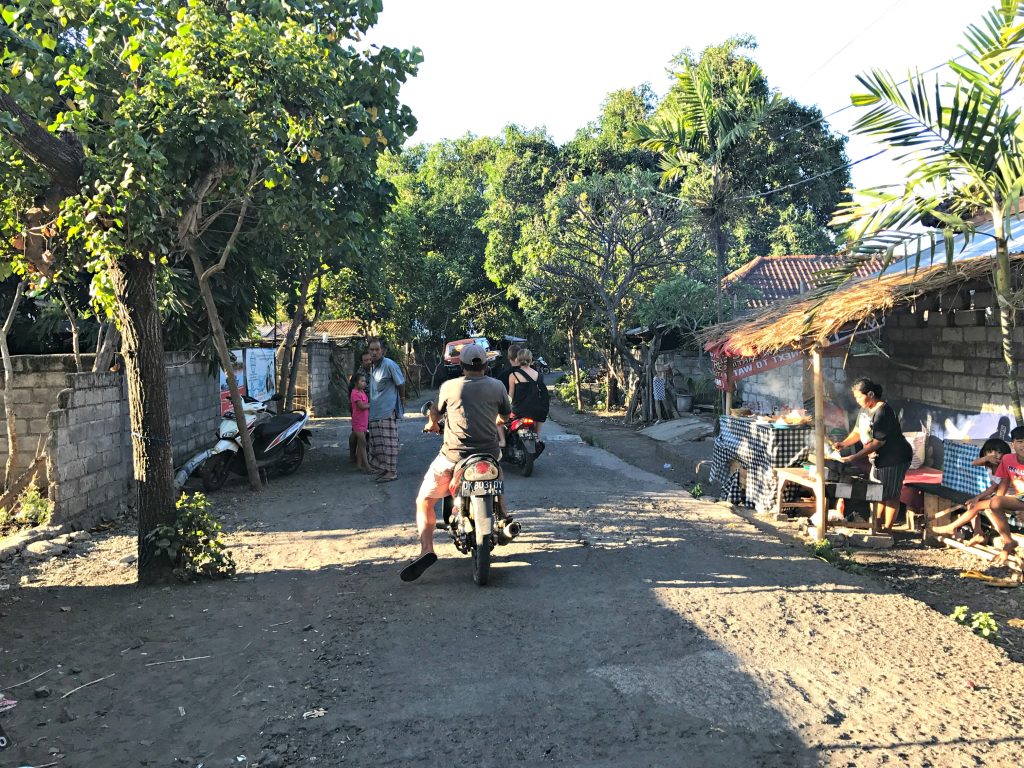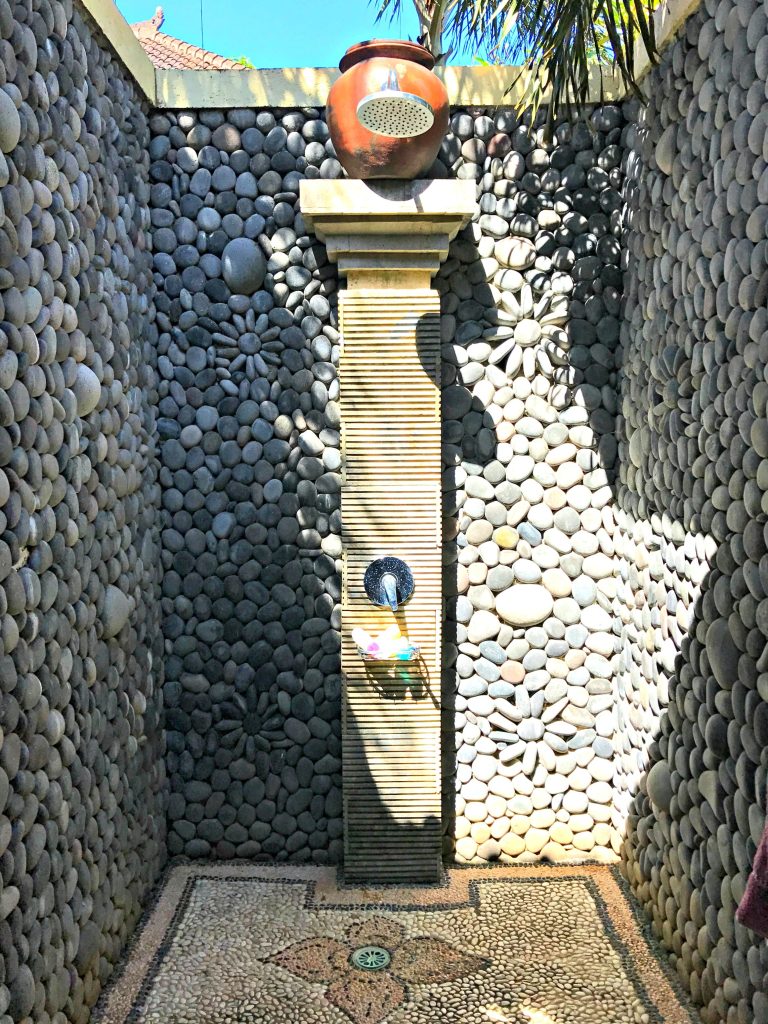Above the Clouds | Beneath the Sea
On the northeastern side of Bali lies Amed. This tiny fishing village is quickly attracting scuba divers and snorkelers from all over the world for the beautiful coral gardens and marine life in the Bali Sea.
Here in a Amed you won’t find the traffic, tourism, and the commercialism of other places in Bali. The streets are narrow, shops and restaurants are small and limited, but the black sand beach, clear water visibility, coral gardens, dive shops, and the hospitality of local Balinese in this growing town, along with the price to stay here, are charming and affordable.

Villa Paradiso
Built in the traditional Balinese style with teak wood doors and windows and tile floors, the villa had all the amenities. Doors opened on all sides to allow the breeze to blow in, the private pool was in the front courtyard, and the one room cottage in the back had an open-air shower. We chose to stay in the cottage in back of the villa, which we loved, instead of the main villa with our friends. I practiced yoga and meditation of the porch every morning overlooking the garden. There are stone and pebble designs are all over Bali, similar to our shower, and volcanic rock is a main building materiel on the island. Black and white represents the balance of opposites (happy and sad, good and evil, etc) and you’ll see black and white buffalo check fabric all over the island at temples and around trees. This pattern is seen as sacred and usually means the spirit resides within. Balinese also incorporate Animism into their religion, and believe the spirit resides in trees, plants, animals, etc. As mentioned in the previous post about Bali, prior to cutting any part of a sacred tree, the priest will ask the tree spirit first. All of these sacred trees are wrapped in black and white fabric, which you’ll see more of below.









Offerings Basket
All over Bali you will see the offerings basket outside homes, businesses, etc. These baskets have different colored flowers, representing different Gods, dried rice, and are sprinkled with holy water. They are made from palm leaves and strips of bamboo, which act as straight pins to keep the leaves together. The villa has a full staff, and one of the ladies taught me how to make the baskets. They make offerings each day to the Gods thanking them for their many blessings, and the lady is the one to make the offering for the business each morning to bless the business, the workers and the customers. This day was the day of the full moon, so the Balinese have a special celebration for that (the Balinese celebrate everything) with offerings, a dance, and special decorations made from dried palm leaves that are folded. Everyone wears traditional Balinese attire, which is often mismatched in color.








Bali Sea
Beach, snorkeling, and a sunset boat ride on a traditional Jukung are musts. We snorkeled off the beach in the coral gardens with a guide. If you’ve been on a black sand beach, you know how hot the sand can get, so take some shoes you can get wet and leave right by the water, so you can slip them on when you get out. The water is very clear and is easy to snorkel right off the beach with good visibility of the coral and fish. The jukung is a traditional fishing boat, so it’s not luxurious, but the sun setting behind Mt Agung (the volcano that has been erupting recently) is gorgeous, along with the view of all the villas and hotels from the water.



Pura Lempuyang
Pura in Balinese means temple. If you are anywhere near this side of the island, you have to go to Lempuyang. Also known as the temple of a thousand steps, this is one of the nine key directional temples in Bali, said to protect Bali from evil spirits. The location, position and layout is considered to be one of the most sacred structures and natural points on the island and marks each of the eight cardinal directions. There are three sections, each relating to Balinese cosmology and corresponding to the three Gods Brahma, Vishnu and Shiva. Lumpuyang is sutiuated on Mt Lempuyang and consists of six temples ascending to the peak of the mountain. There are 1,700 plus steps, and it take 2 hours to climb to the top, 2,000 ft above sea level. It’s magical and spiritual. If you don’t find spirit here, I doubt you will. It is moving, jaw-dropping and awe-inspiring. Below is the first temple where you are greeted by the giant Naga (dragon) heads, whose tail extends up the staircase to the top of the first temple. Red, black and white fabric represents the three Gods, and black and white covers the tail reminding us, this is a sacred place. Covered by that cloud behind me in the photo below at Lempuyang’s famous gate in the clouds is the towering volcano, Mt Agung. As we got to the top of this first temple, for a brief moment, the clouds parted and the volcano silhouette became visible. It’s hard to believe something so massive and almost menacing is just behind those clouds. Mystical and magical Bali will make you believe in Animism-that spirit resides in everything around us. The journey at Lemupyang will prove it to you.




Dining
We had coffee every morning at Pazzo Bali across the street from the villa. The service was excellent, and the restaurant overlooks the Pazzo Hotel pool. We were blown away to find out it was only $50 a night to stay here. If you’re on a tight budget, there are so many options in Bali.

We had dinner at Apa Kabar on the beach one night and the food was great, but with this kind of setting, I would have been fine with plain toast. 😉


The Balinese love their birds and flowers. Most all the homes have at least one bird cage outside, sometimes more, and as I’ve mentioned in my previous blogs, the marigold is everywhere in Bali. Marigolds are around all the statues in Bali, as offerings to the Gods, and many have frangipani flowers tucked behind their ears or in their hair, if there is room.




This is my third in the Bali series. I have one more blog post to share from another side of the island. I hope you have enjoyed it!
Xo,
Cass

